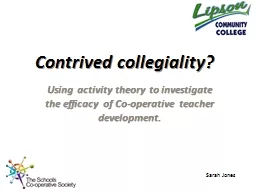

Contrived collegiality Sarah Jones The Sigmoid Curve Handy 1984 Holistic meaning Power sharing Well being Transforming dialogue Woods 2011 C ollegiality Spontaneous Voluntary Development oriented ID: 533177
Download Presentation The PPT/PDF document "Using activity theory to investigate the..." is the property of its rightful owner. Permission is granted to download and print the materials on this web site for personal, non-commercial use only, and to display it on your personal computer provided you do not modify the materials and that you retain all copyright notices contained in the materials. By downloading content from our website, you accept the terms of this agreement.
Slide1
Using activity theory to investigate the efficacy of Co-operative teacher development
.
Contrived collegiality?
Sarah JonesSlide2
The Sigmoid Curve
Handy, 1984Slide3
Holistic meaning
Power
sharing
Well being
Transforming dialogue
Woods, 2011Slide4
Collegiality
SpontaneousVoluntary Development oriented Pervasive across time and space Unpredictable
(Hargreaves, 2008)Slide5
Contrived collegiality
Administratively regulated.Compulsory Implementation-oriented
Fixed in time and space.Predictable
(Hargreaves, 2008)Slide6
Engeström
(1999) Slide7
Engeström
(1999) Slide8
Conclusion
Conflict can now be viewed either as an opportunity to explore issues of divergence or sources of subversion. Collegiality is difficult to implement and may only be seen sporadically. Organisational-induced
collegiality exists in the SIG. This makes its an object-orientated, collective and culturally mediated human activity. W
ider political context is outside the activity but is still controlling it.Slide9
Some questions….
How do we overtly share power? How do we ‘loosen’ experimentation/ risk-taking but keep ‘strength’ over norms to allow teachers to tolerate losses in self-esteem or damage to new identities born
out of new learning?How do we continue a process of self-monitoring in a socially constructed platform to enable developments to continue, but avoid surveillance and damaging power dynamics?